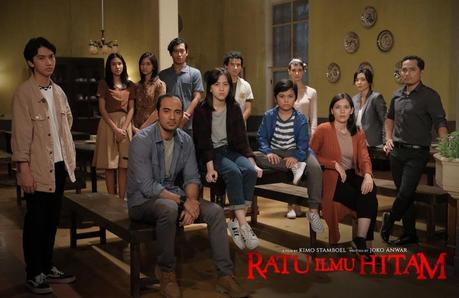There is a certain kind of similarity between Kimo Stamboel’s Ratu Ilmu Hitam a.k.a. The Queen of Black Magic and Joko Anwar’s Satan’s Slave. Written by Anwar based on cult horrors from the 1980s, none of them is a merely verbatim remake; instead, they are spiritual remakes that capture the fright and the wickedness of the original to create a completely different story. Call it a diabolical reborn, which defines both works best as phantasmal throwbacks.
Stamboel (in a very productive year, also directing another horror blockbuster, DreadOut, earlier this year) exhumes the wicked sense of terror he once showed in his directorial collective, The Mo Brothers (Macabre, Killers, Headshot) with Timo Tjahjanto (May the Devil Take You, The Night Comes for Us). While the source material is renowned for the surreal yet straightforward act of revenge, the remake takes a slightly different turn. Anwar’s story is built upon an underlying mystery, which Stamboel chooses to paint with blood—a lot of it.

The director’s penchant for macabre comes later in the movie; as the movie tends to start it placidly, taking its time for carefully-staged plantings. This pattern similarly mirrors Anwar’s Satan’s Slave quite religiously. The narrative takes its time to familiarize the audiences with the characters and the remote setting in an orphanage. Epicentral characters are Hanif (Ario Bayu, fresh from Perempuan Tanah Jahanam), Anton (Tanta Ginting), and Jefri (Malaysian actor, Miller Khan), who grew up in the orphanage privately owned and managed by Mr. Bandi (Yayu Unru, Posesif). Bringing along their own families, the three friends are reunited after receiving news—from their fellow orphans (Ade Firman Hakim and Sheila Dara Aisha) who live and work at the very same place—about Mr. Bandi’s critical condition.
Unbeknownst to them, the warm reunion is set against an impending doom unraveled only after around 30 minutes in the movie. Within the first act, Stamboel shows around and, on the surface, explains how each character is connected to each other and how each of them deals with their personal traits. For example, Anton’s hypochondriac wife, Eva (Imelda Therine), keeps wearing masker and gloves preventing certain kinds of rash from relapsing; meanwhile, Jefri’s anorexic partner, Lina (Salvita Decorte), refrains herself from eating any kind of food for fear of weight-gaining. At the same time, Stamboel visually familiarizes audiences with the geography of the orphanage. Up to this point, the titular villain hasn’t even shown any bad omen; unlike the super straightforward source material.
When the terror is unleashed, however, Ratu Ilmu Hitam channels the source material’s wild, campy, and absurd monstrosity and doubles it down with Stamboel’s signature gore-fest. The result is an unapologetic torture-porn that might remind you of the exploitation cinema’s golden era. Stamboel has the eye for visceral, visual terror in a series of motion pictures that “we can feel.” Each moment of the gore-fest is explicitly staged to trigger some unpleasant, disturbing feelings. Slasher aficionados might have satisfied smirk as the story goes on.
While having tons of fun torturing people with insidious force from beyond the logic, Ratu Ilmu Hitam somehow slips in building the elevating sense of terror. The tortures are almost randomly picked with unstable tension. Anwar’s script and Stamboel’s visuals could have gone hand-in-hand raising the tension of each torture gradually, instead of randomly. Fortunately, the finale—in which the titular queen eventually reveals herself—is a delightful inferno moment. The hell-on-earth scene is completely harrowing, even when the scene somehow feels out of place and ends quite abruptly.
Casting several cash-in actors, such as Zara Adhisty (Dua Garis Biru) and Ari Irham (Terlalu Tampan) in their first horror venture shows just how ambitious and confident the new Ratu Ilmu Hitam is in dragging casual viewers into this segmented horror. And yet, their characters barely matter for the whole picture; removing those characters from the story means nothing narratively. Their role is eclipsed by Muzakki Ramdhan (Gundala). That being said, this drawback does not make the whole movie less enjoyable. If you are a believer of horror spectacles, Ratu Ilmu Hitam is there to please you with enough mystery, enough scares, and an abundant size of macabre to remind you of the director’s initial reputation.
Stitched with harrowing imagery and visuals that you can feel, Ratu Ilmu Hitam takes its time to present its much delightful torture porn—a dreadful throwback indeed.

Further movie information: Ratu Ilmu Hitam on FilmIndonesia.or.id
